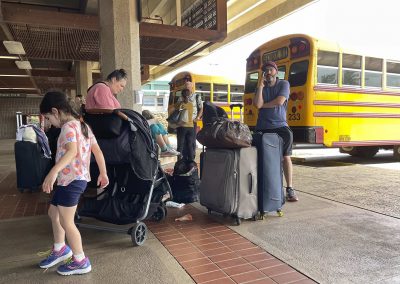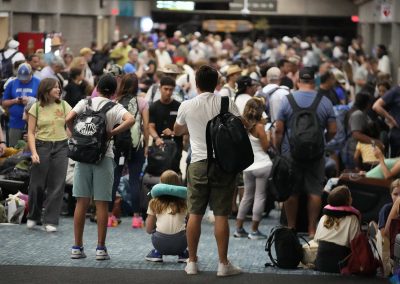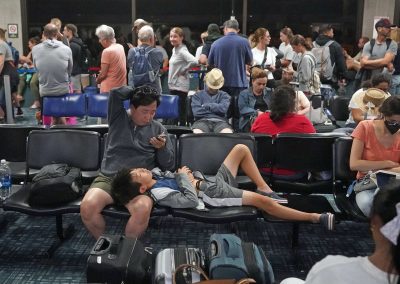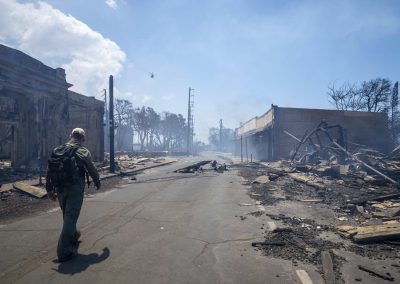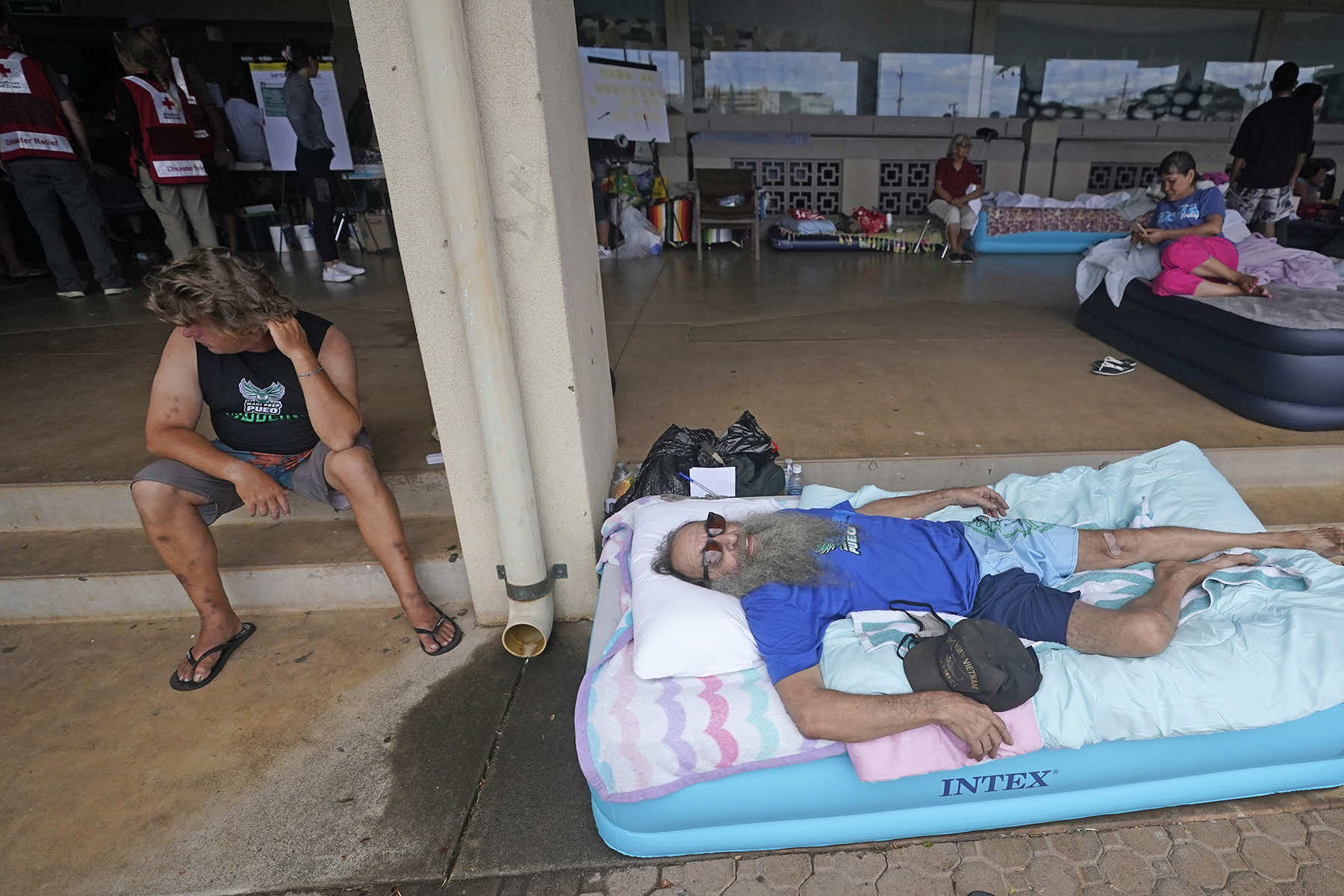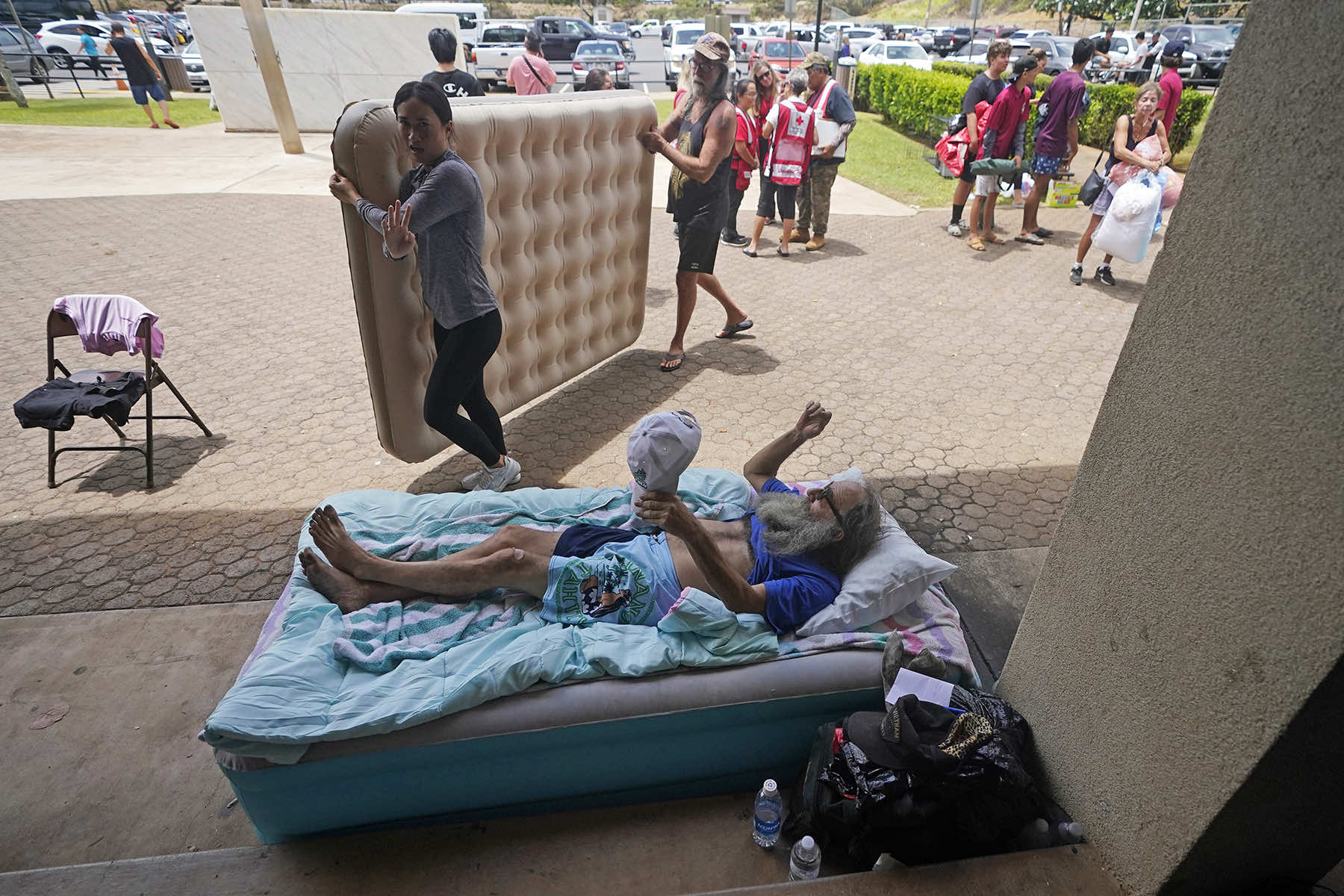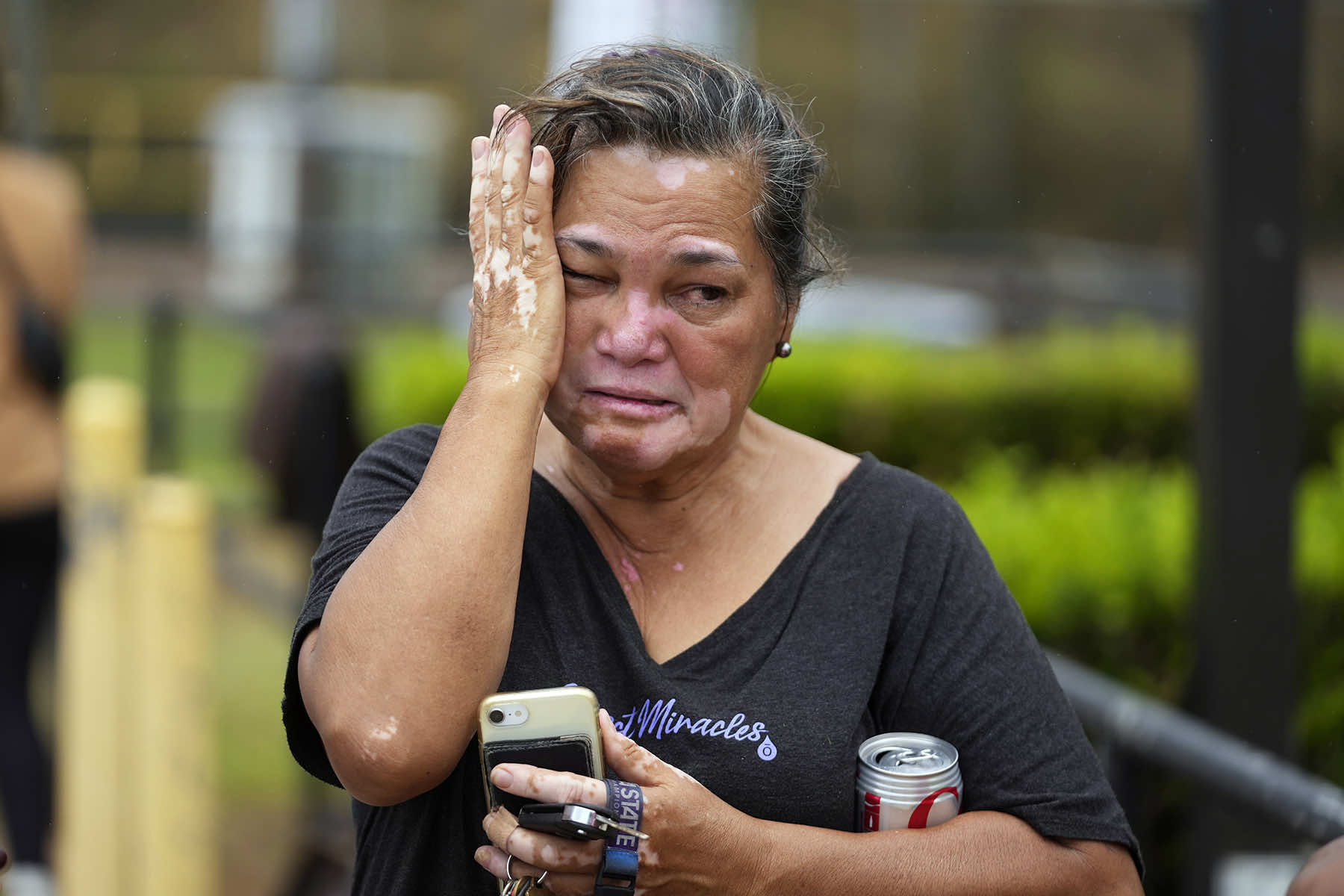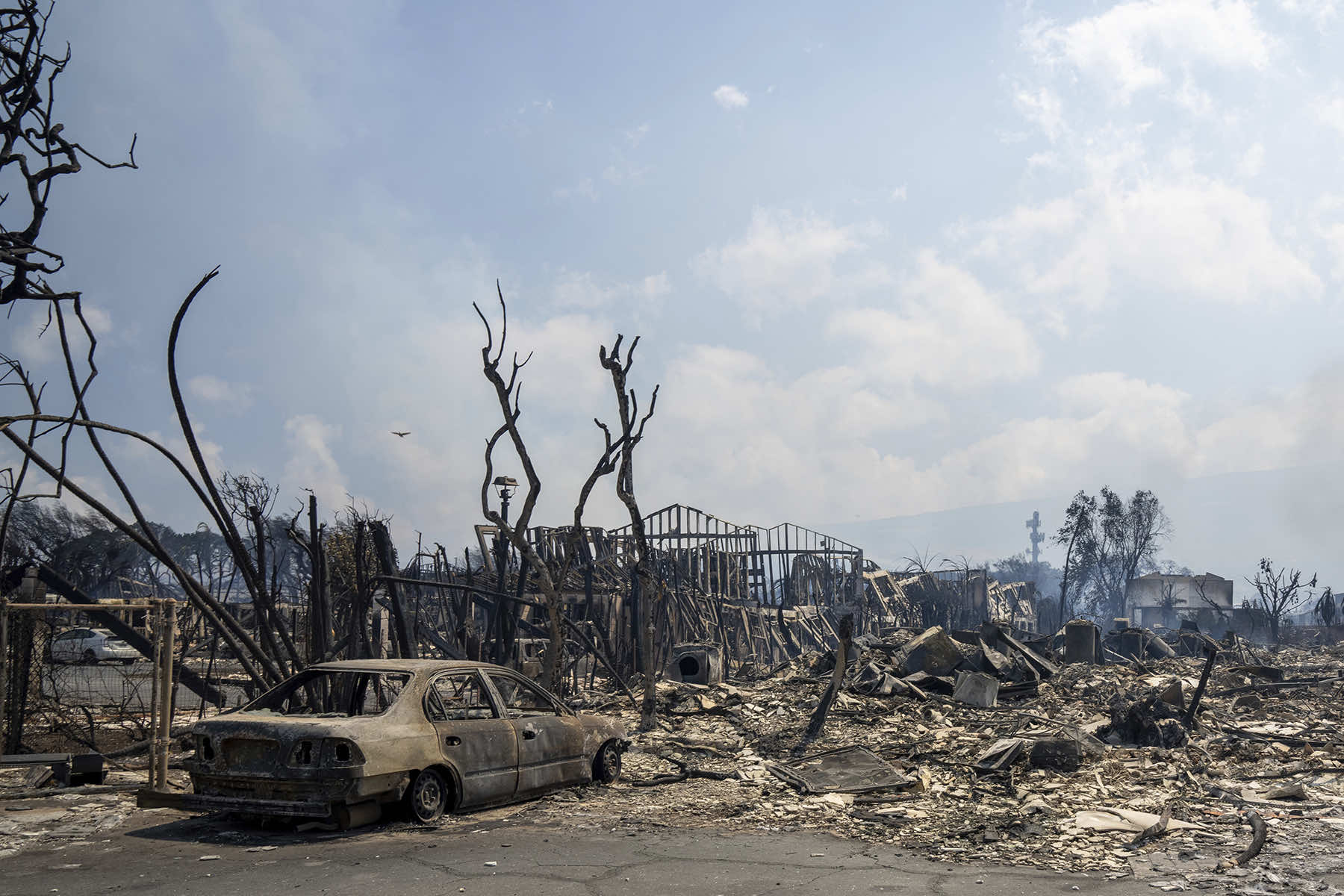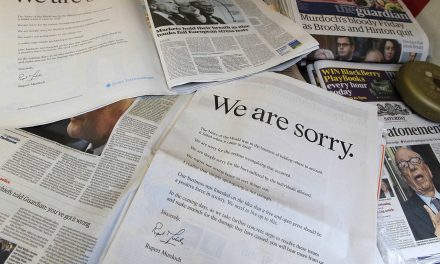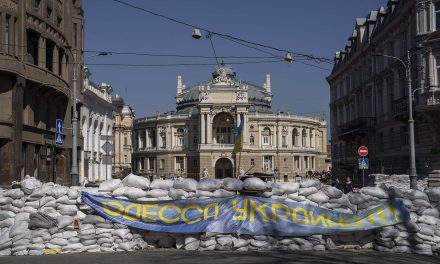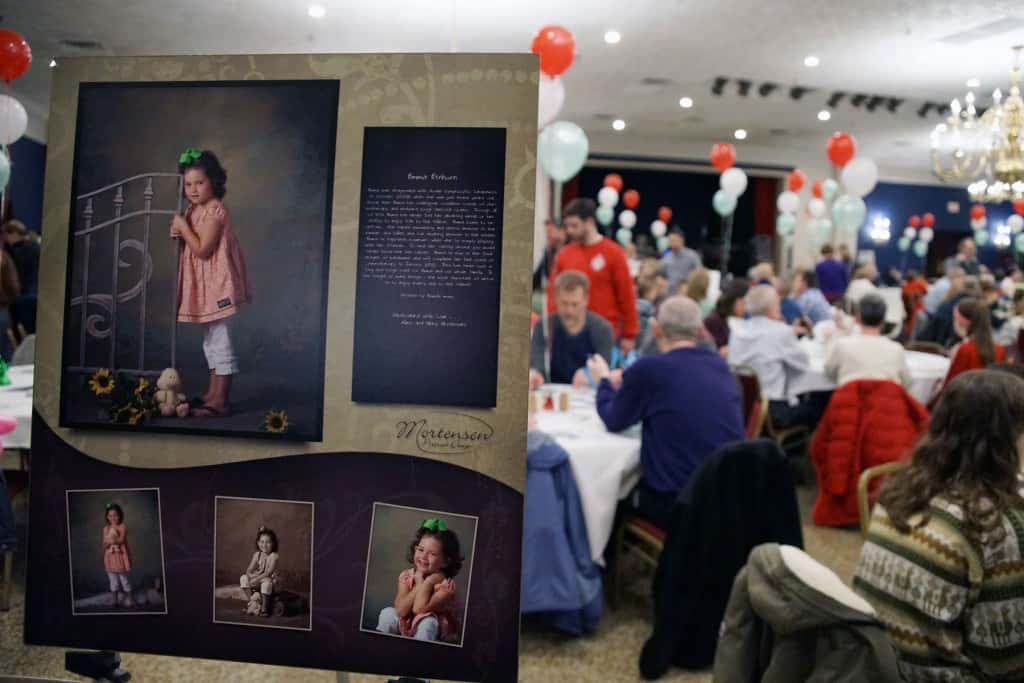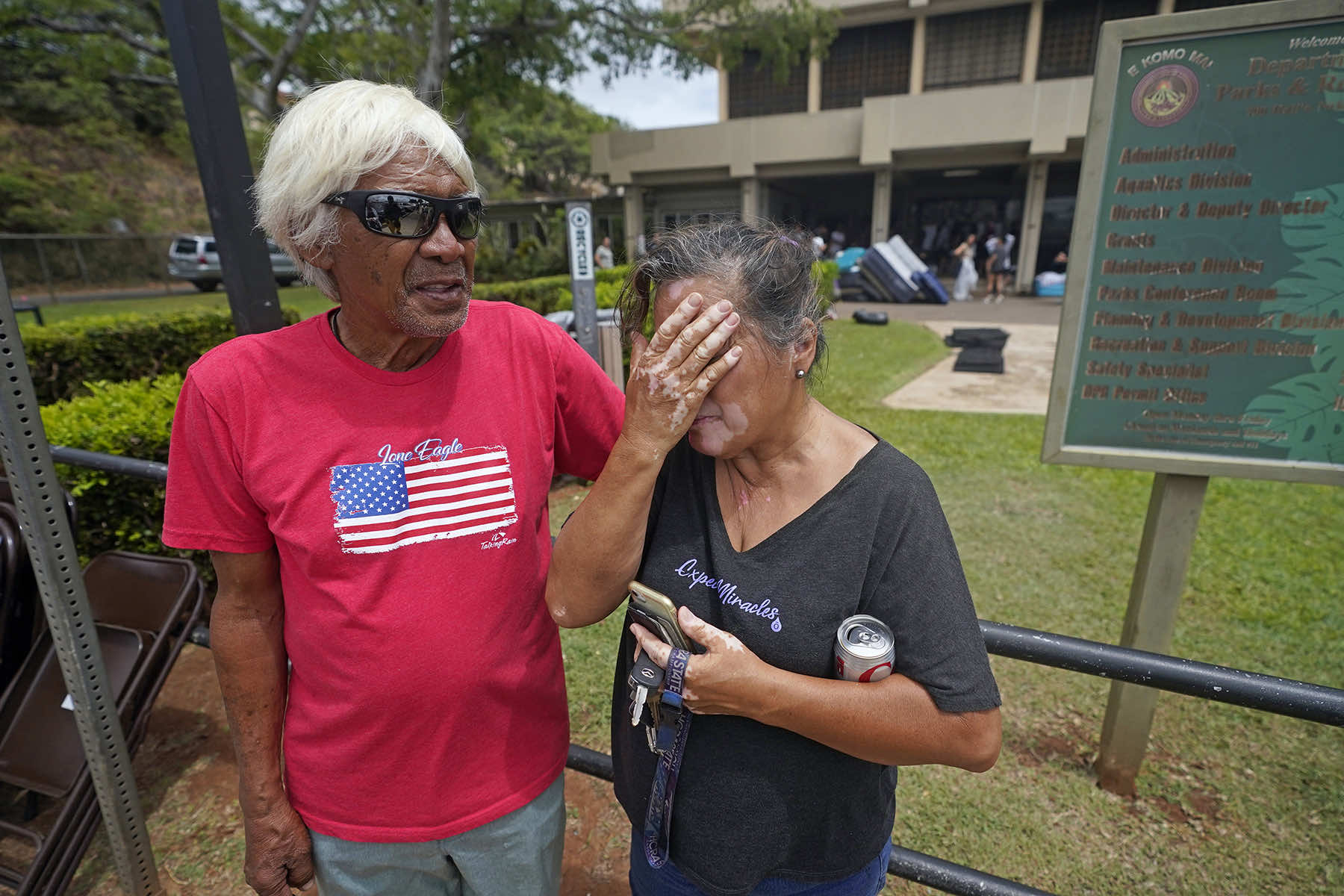
Retired mailman and Vietnam veteran Thomas Leonard lived in the historic former capital of Hawaii for 44 years until this week, when a rapidly moving wildfire burned down his apartment, melted his Jeep, and forced him to spend four terrifying hours hiding from the flames behind a seawall.
“I’ve got nothing left,” Leonard said on August 10 as he sat on an inflatable mattress outside a shelter for those who fled the blaze that decimated the town of Lahaina. “I’m a disabled vet, so now I’m a homeless vet,” he added with a small laugh.
The fire that tore across the coastal Maui town and caught many by surprise has already claimed dozens of lives — a toll expected to climb — and burned more than 1,000 buildings. It has turned a centuries-old hamlet beloved by travelers and locals alike into a charred, desolate landscape.
The devastation has resonated worldwide in part because tourists from around the globe flock to Maui to enjoy its white sand beaches, including many who stop to visit the old whaling village and capital of the former Hawaiian kingdom.
Thousands fled Maui after the fires rousted them from their resort hotels and sent them scrambling from their sun chairs on August 8. But for thousands of people who call Lahaina home, there is no flight to catch and no home to return to. They have simply lost everything.
On Front Street, Lahaina’s main thoroughfare, Deborah Leoffler lost a home that has been in her family since 1945. Five generations stayed there, starting with her grandfather, who was a Lahaina police sergeant. Her youngest son had been planning to move home from the mainland to live there.
She evacuated so quickly she left her debit cards on her nightstand and now cannot access her bank account.
“But I still have my family, and that’s what counts,” she said.
Myrna Ah Hee’s home is in one of the few subdivisions in Lahaina spared destruction. But she and her husband, Abraham, have not been able to find his brother, a Vietnam veteran with post-traumatic stress disorder who has been living in Lahaina’s homeless shelter.
The Ah Hees spent August 10 scouring evacuation shelters across the island from Lahaina to see if he might have made it out.
Her extended family was hit badly: Her parents lost their home, as did her son, one of her uncles and a cousin. Her son-in-law was staying in a house that had long been in her husband’s family, but that burned down too.
She said those born and raised in Lahaina like her and her husband have to “stand up and make it what it was.”
“Where do you begin?” she asked rhetorically. “It’s town we have to bring back — but also families, classmates, friends.”
Leonard, the retired mailman, said he didn’t know about the fire until he smelled smoke from his apartment on Front Street and went outside to investigate. He had been in an information vacuum all day after the power had gone out early on August 8, leaving him and neighbors without electricity, internet, and cellphone service. The county’s emergency sirens — which warn people of the need to evacuate for tsunamis and other natural disasters — didn’t sound.
He grabbed his wallet, key,s and credit cards and jumped in his car to leave, only to find a traffic jam. He waited, in hopes the line of vehicles would move, until the cars ahead of him started exploding one by one.
“My Jeep had a soft top, and I knew it was going to go. And I just said, ‘I’m out of here,'” Leonard recalled.
The 74-year-old ran over to the seawall that shields the town from encroachment from the ocean, joining about 70 others. About 20 of them jumped in the water to get away from the flames. Leonard said he felt safter crouched down next the wall on the ocean side, where he could let the wind carry hot ash over him.
Even so, cinder seared holes in his shorts and shirt, and he suffered burns on his legs.
“There were flames coming and sparks everywhere,” he said.
One person at the seawall flashed S.O.S. out to the ocean, which Leonard said alerted the Coast Guard. The Coast Guard contacted Maui firefighters, who then escorted the group on foot through the flames to a supermarket parking lot at about 9:30 p.m.
A propane tank exploded down the block not long after they passed.
“It was just like, boom, a gigantic mushroom at that house,” he said.
As Governor Josh Green expressed it simply: “Lahaina, with a few rare exceptions, has been burned down.”
Leonard is not sure what he will do next. The pharmacy at the evacuation shelter has contacted the Department of Veterans Affairs to help him get his prescriptions. He is thinking how he will have to contact his homeowner’s and car insurance providers. And get in touch with his friends and family. They do not know where he is — but he is registered with the Red Cross so they can find him.
Still, he doesn’t know if he will will go back to Lahaina, especially given how long it will probably take to rebuild.
“I have no idea where I’m going to go,” he said.
How to help or donate in response to the deadly wildfire in Maui
Many people are already looking for ways to support the response and provide relief to those affected, while rescue and emergency operations continue.
The full extent of the damage and the recovery needs may not be known for up to a week, said Regine Webster, vice president of the Center for Disaster Philanthropy, and she urged people to be patient before deciding where to give their support.
“You literally have to wait for the firefighters to complete their work before that damage assessment can be fully realized,” she said.
Philanthropy experts recommend giving to experienced organizations that are well-situated to respond to a specific disaster. Major disaster response organizations like the American Red Cross have said they are already communicating with local and federal governments to provide assistance.
Webster also urged potential donors to support organizations with deep local ties and knowledge of the effected communities.
“To the extent that we can all slow down, wait a week, wait two weeks, to understand where the greatest needs are, and then look toward organizations that are really meeting those needs, again, prioritizing organizations with specific disaster expertise and organizations that are local in nature,” Webster said.
The Council for Native Hawaiian Advancement pledged to match donations — up to $100,000 initially, now increased to $1 million — for a campaign they began Wednesday, with initial support from the Alakaʻina Foundation Family of Companies. An online tracker shows that more than $442,000 has been given from 3,300 people as of August 10.
The crowdfunding site, GoFundMe, has vetted fundraisers for individuals and families who lost property or were injured in the fires. That means the site has taken steps to verify the identity of the organizer and has collected those campaigns on a hub on its website. GoFundMe will take additional verification steps before releasing the funds to the organizer, as well as deduct a transaction fee.
Direct donations to individuals or families can be a powerful way to make an impact, but potential donors should be careful in responding to appeals on social media for donations to individuals, through electronic payment apps like Venmo or Cash App, experts say.
Potential donors should also consider if it is important to them to claim a tax benefit for their donation. Only tax-exempt nonprofit organizations will provide a receipt that people who itemize their taxes can use to claim a deduction.
The Hawaii Community Foundation said it has raised $3 million for its Maui Strong Fund in 24 hours and is not collecting any fees on gifts to the fund.
“Funding is focused on basic necessities, including sheltering families who have lost homes, food and clothing. We are humbled by the support and aloha shared locally and across the globe for Maui families,” said Michelle Kauhane, the foundation’s senior vice president, in a statement.
The foundation is collaborating with other nonprofits and government officials to assess immediate needs, she said. The Center for Disaster Philanthropy will launch a fund specific to the Hawaii wildfires that prioritizes equity in recovery, Webster said.
“We actually will wait several months before we understand the full range of needs that exist on Maui and other islands that are also facing wildfires,” she said. “And we will not invest our funds until such time as we understand what those medium and long-term needs are.”

